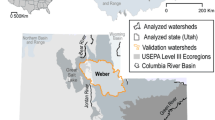Abstract
In this article a GIS method is presented for riparian environmental buffer generation. It integrates a scientifically tested buffer width delineation model into a GIS framework. Using the generally available data sets, it determines buffer widths in terms of local physical conditions and expected effectiveness. Technical burdens of data management, computation, and result presentation are handled by the GIS. The case study in which the method was used to evaluate the stream buffer regulations in a North Carolina county demonstrates its capability as a decision support tool to facilitate environmental policy formulation and evaluation, and environmental dispute resolution.
Similar content being viewed by others
Literature Cited
Antenucci, J. C., K. Brown, P. L. Croswell, M. J. Kevancy, and H. Archer. 1991. Geographic information systems: A guide to the technology. Van Nostrand Reinhold, New York, 301 pp.
Barfield, B. J., E. W. Tollner, and J. C. Hayes. 1977. Prediction of sediment transport in grassed media. ASAE paper No. 77-2023. American Society of Agricultural Engineers, St. Joseph, Michigan, 23 pp.
Budd, W. W., P. L. Cohen, P. R. Saunders, and F. R. Steiner. 1987. Stream corridor management in the pacific northwest.Environmental Management 11:587–605.
Cabarrus County Planning and Zoning Department. 1992. Zoning ordinance (updated through 1 January 1992). Cabarrus County Planning and Zoning Department, Concord, North Carolina, 160 pp.
Clark, J. R. 1977. Coastal ecosystem management. John Wiley & Sons, New York, 811 pp.
Engman, E. T., and M. Asce. 1986. Roughness coefficients for routing surface runoff.Journal of Irrigation and Drainage Engineering 112:39–53.
Environmental Systems Research Institute. 1989a. ARC/INFO user guide: Vol 1. Environmental Systems Research Institute, Redlands, California, 220 pp.
Environmental Systems Research Institute. 1989b. TIN user guide: ARC/INFO surface modeling and display. Environmental Systems Research Institute, Redlands, California, 190 pp.
Flanagan, D. C., G. R. Foster, W. H. Neibling, and J. P. Burt. 1989. Simplified equations for filter strips design.Transactions of the American Society of Agricultural Engineers 32:2001–2007.
Jacobs, T. C., and J. W. Gilliam. 1985. Headwater stream losses on nitrogen from two coastal plain watersheds.Journal of Environmental Quality 14:467–472.
Karr, J. R., and I. J. Schlosser. 1978. Water resources and the land-water interface.Science 201:229–234.
Lowrance, R. R., R. L. Todd, J. Fail, O. Hendrickson, R. Leonard, and L. Asmussen. 1984. Riparian forests as nutrient filters in agricultural watersheds.Bioscience 34:374–377.
Lowrance, R. R., R. Leonard, and J. M. Sheridan. 1985. Managing riparian ecosystems to control nonpoint pollution.Journal of Soil and Water Conservation 40:87–91.
North Carolina Department of Environment, Health, and Natural Resources, Division of Environmental management. 1991. An evaluation of vegetative buffer areas for water quality protection. Report No. 91-02. North Carolina Department of Environment, Health, and Natural Resources, Division of Environmental Management, Water Quality Section, Raleigh, North Carolina, 19 pp.
Palfrey, R., and E. Bradley. 1982. Buffer area study. Maryland Department of Natural Resources, Coastal Resources Division, Tidewater Administration, Baltimore, Maryland, 30 pp.
Phillips, J. D. 1989a. Effect of buffer zones on estuarine and riparian land use in eastern North Carolina.Southeastern Geographer 29:136–149.
Phillips, J. D. 1989b. Evaluation of North Carolina's estuarine shoreline area of environmental concern from a water quality perspective.Coastal Management 17:103–117.
Phillips, J. D. 1989c. An evaluation of the factors determining the effectiveness of water quality buffer zones.Journal of Hydrology 107:133–145.
Philips, J. D. 1989d. Nonpoint source pollution control effectiveness of riparian forests along a coastal plain river.Journal of Hydrology 110:221–237.
Phillips, J. D. 1989e. Evaluating estuarine shoreline buffer zones for nonpoint source pollution control. Pages 399–411in Proceedings of coastal zone '89. American Society of Agricultural Engineers, New York.
Soil Conservation Service. 1991. Filter strip specification, field office technical guide. US Department of Agriculture, Soil Conservation Service, Raleigh, North Carolina, 6 pp.
Stephens, R. B. 1988. Soil survey of Cabarrus county, North Carolina. US Department of Agriculture, Soil Conservation Service, Raleigh, North Carolina, 130 pp.
Swift, L. W., Jr. 1986. Filter strip widths for forestry roads in the southern Appalachians.Southern Journal of Applied Forestry 10:27–34.
Trimble, G. R., Jr., and R. S. Sartz. 1957. How far from a stream bank should a logging road be located?Journal of Forestry 55:339–341.
Author information
Authors and Affiliations
Rights and permissions
About this article
Cite this article
Xiang, WN. Application of a GIS-based stream buffer generation model to environmental policy evaluation. Environmental Management 17, 817–827 (1993). https://doi.org/10.1007/BF02393902
Issue Date:
DOI: https://doi.org/10.1007/BF02393902




